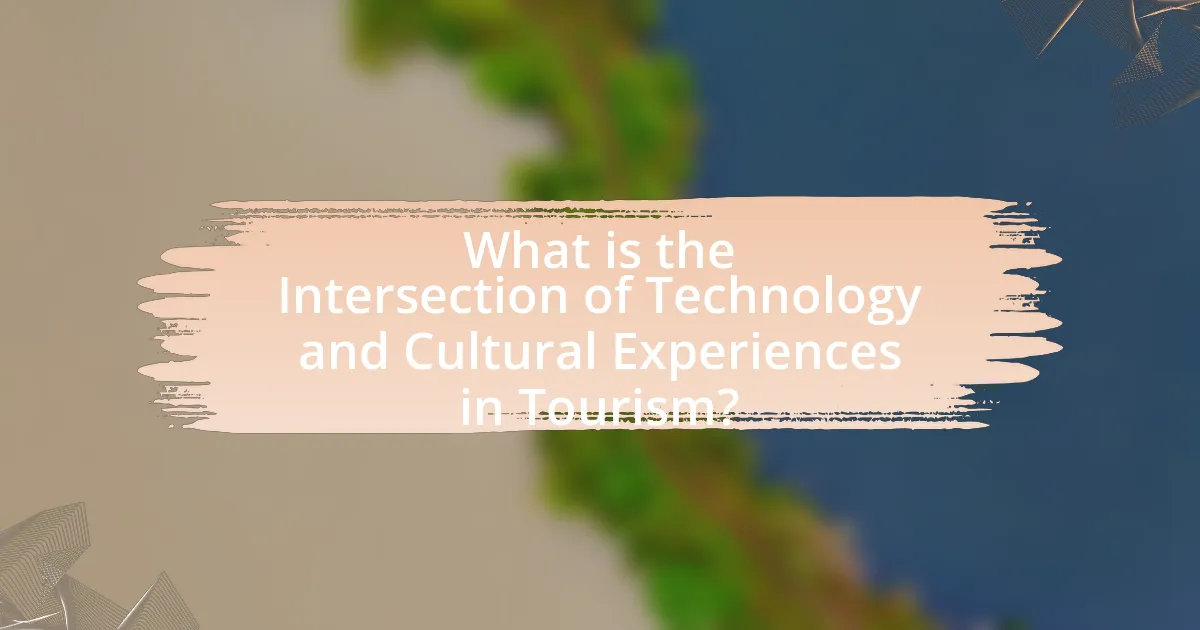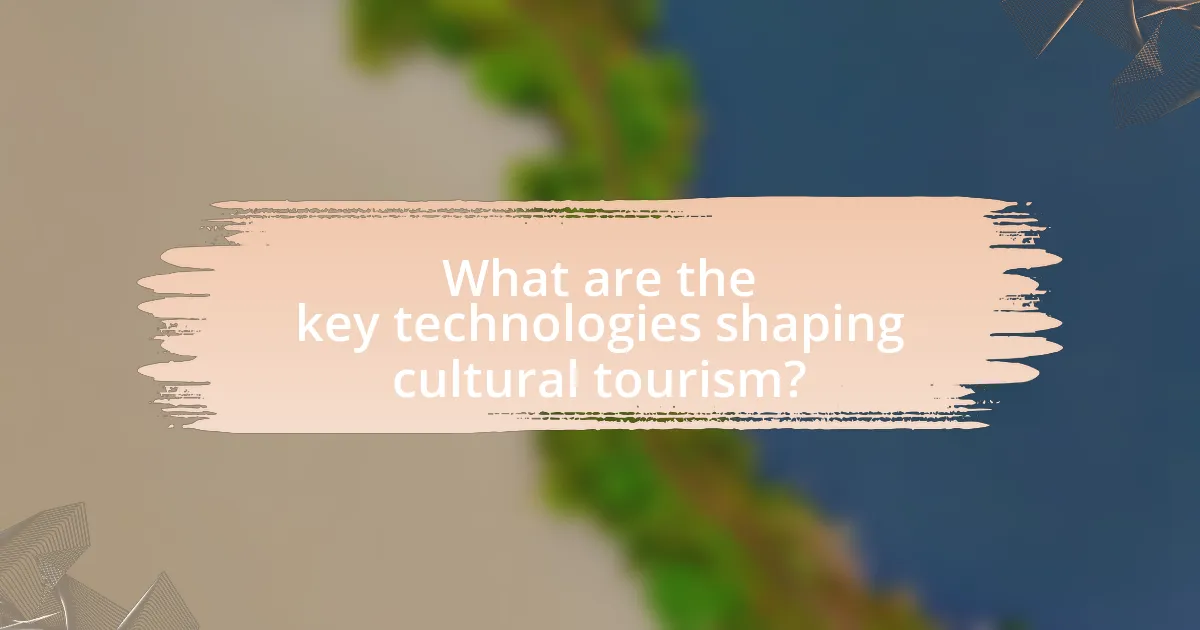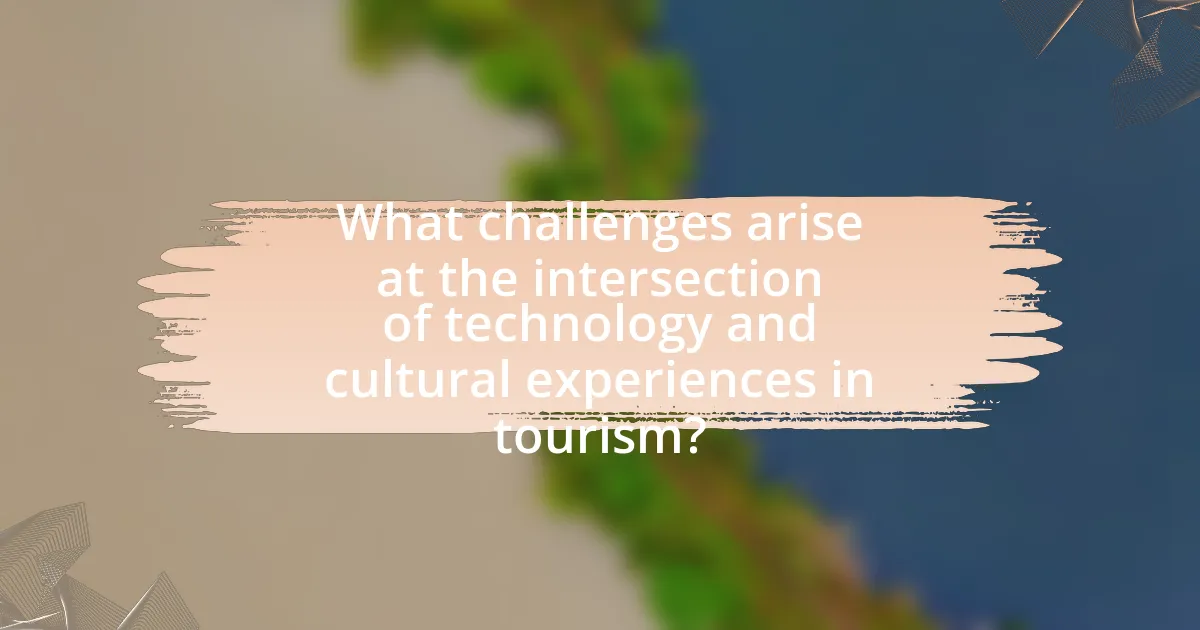The article examines the intersection of technology and cultural experiences in tourism, highlighting how digital tools such as virtual reality, augmented reality, and mobile applications enhance travelers’ engagement with cultural heritage and local traditions. It discusses the significant preference among travelers for technology-driven experiences, the types of technologies commonly used in tourism, and their role in fostering cultural understanding and appreciation. Additionally, the article addresses the potential benefits for both tourists and local cultures, while also considering challenges such as cultural commodification and data privacy concerns. Key technologies shaping cultural tourism and best practices for responsible integration are also explored, emphasizing the importance of balancing technological advancements with cultural integrity.

What is the Intersection of Technology and Cultural Experiences in Tourism?
The intersection of technology and cultural experiences in tourism refers to the integration of digital tools and platforms that enhance the way travelers engage with cultural heritage and local traditions. Technologies such as virtual reality, augmented reality, and mobile applications provide immersive experiences that allow tourists to explore historical sites and cultural narratives in innovative ways. For instance, a study by the World Economic Forum highlights that 70% of travelers prefer using technology to enhance their cultural experiences, indicating a significant trend towards tech-driven tourism. This integration not only enriches the visitor experience but also supports local economies by promoting cultural awareness and preservation.
How does technology influence cultural experiences in tourism?
Technology significantly enhances cultural experiences in tourism by providing immersive and interactive platforms for engagement. For instance, virtual reality (VR) allows travelers to explore historical sites and cultural landmarks from anywhere in the world, offering a deeper understanding of local traditions and histories. According to a study by the World Economic Forum, 75% of travelers expressed interest in using VR to enhance their travel experiences. Additionally, mobile applications facilitate access to cultural information, enabling tourists to learn about local customs, languages, and cuisines in real-time. This integration of technology not only enriches the travel experience but also fosters cultural appreciation and understanding among diverse populations.
What types of technology are commonly used in tourism?
Commonly used technologies in tourism include online booking systems, mobile applications, virtual reality, and artificial intelligence. Online booking systems streamline the reservation process for flights, accommodations, and activities, enhancing user convenience. Mobile applications provide travelers with real-time information, navigation, and personalized recommendations, improving the overall travel experience. Virtual reality allows potential tourists to explore destinations and attractions before visiting, influencing their travel decisions. Artificial intelligence is utilized in customer service through chatbots and personalized marketing, optimizing engagement and satisfaction. These technologies collectively enhance efficiency, accessibility, and user experience in the tourism sector.
How do these technologies enhance cultural understanding?
Technologies enhance cultural understanding by facilitating access to diverse cultural content and experiences. For instance, virtual reality (VR) allows users to immerse themselves in different cultural environments, providing firsthand experiences of traditions, rituals, and daily life in various societies. Additionally, social media platforms enable real-time sharing of cultural events and practices, fostering global conversations and connections. Research indicates that 70% of travelers use technology to learn about local cultures before visiting, demonstrating its role in promoting cultural awareness and appreciation.
Why is the integration of technology and culture important in tourism?
The integration of technology and culture is important in tourism because it enhances the visitor experience and promotes cultural preservation. Technology, such as mobile applications and virtual reality, allows tourists to access information about cultural sites and local traditions in real-time, enriching their understanding and engagement. For instance, augmented reality applications can provide historical context and interactive storytelling at cultural landmarks, making the experience more immersive. Additionally, technology facilitates the documentation and sharing of cultural practices, which can help preserve them for future generations. According to a report by the World Economic Forum, the use of technology in tourism can increase visitor satisfaction by up to 30%, demonstrating its significant impact on enhancing cultural experiences.
What are the potential benefits for tourists?
Tourists can experience enhanced cultural immersion and convenience through technology. Technologies such as augmented reality (AR) and virtual reality (VR) provide interactive experiences that allow tourists to engage with cultural sites in innovative ways, enriching their understanding and appreciation of local heritage. For instance, a study by the World Economic Forum highlights that 70% of travelers prefer destinations that offer digital experiences that enhance cultural engagement. Additionally, mobile applications facilitate easier navigation and access to information, improving overall travel efficiency and satisfaction.
How can local cultures benefit from technological integration?
Local cultures can benefit from technological integration by enhancing their visibility and accessibility to a global audience. This integration allows for the preservation and promotion of cultural heritage through digital platforms, such as virtual tours and online exhibitions, which can attract tourists and foster cultural exchange. For instance, UNESCO reports that digital tools have helped in the preservation of intangible cultural heritage by documenting traditional practices and making them available online, thus ensuring their survival and appreciation. Additionally, local artisans can leverage e-commerce platforms to reach wider markets, increasing their income and sustaining traditional crafts.

What are the key technologies shaping cultural tourism?
Key technologies shaping cultural tourism include virtual reality (VR), augmented reality (AR), mobile applications, and big data analytics. VR allows users to experience cultural sites and events remotely, enhancing accessibility and engagement. AR enriches real-world experiences by overlaying digital information onto physical locations, providing interactive storytelling. Mobile applications facilitate navigation, ticketing, and personalized recommendations, improving the overall visitor experience. Big data analytics enables tourism providers to understand visitor preferences and behaviors, allowing for tailored marketing strategies and improved service offerings. These technologies collectively enhance cultural tourism by making experiences more immersive, personalized, and data-driven.
How do virtual reality and augmented reality impact cultural experiences?
Virtual reality (VR) and augmented reality (AR) significantly enhance cultural experiences by providing immersive and interactive environments that allow users to engage with cultural artifacts and historical contexts in unprecedented ways. For instance, VR can transport users to historical sites or cultural events, enabling them to experience these locations as if they were physically present, which can deepen understanding and appreciation of different cultures. AR, on the other hand, overlays digital information onto the real world, allowing users to interact with cultural landmarks through enhanced storytelling and contextual information, thereby enriching their experience. Research indicates that 70% of users reported a greater interest in cultural heritage after experiencing it through VR or AR, highlighting the effectiveness of these technologies in fostering cultural engagement.
What are the applications of VR and AR in tourism?
Virtual Reality (VR) and Augmented Reality (AR) are increasingly applied in tourism to enhance visitor experiences and engagement. VR allows users to immerse themselves in virtual environments, enabling them to explore destinations, historical sites, or attractions from anywhere in the world, which can influence their travel decisions. For instance, VR tours of museums or landmarks can provide a realistic preview that encourages actual visits.
AR, on the other hand, enhances real-world experiences by overlaying digital information onto physical environments. This application is evident in mobile apps that provide interactive guides, historical context, or translations when users point their devices at specific locations or objects. For example, the use of AR in city tours can enrich the experience by displaying historical facts or visual reconstructions of ancient sites.
Both technologies are supported by research indicating that immersive experiences can significantly increase user engagement and satisfaction in tourism, as evidenced by studies showing that 70% of users felt more connected to a destination after experiencing it through VR.
How do these technologies change the way tourists engage with culture?
Technologies such as augmented reality (AR), virtual reality (VR), and mobile applications significantly change the way tourists engage with culture by providing immersive and interactive experiences. These technologies allow tourists to explore cultural sites in a more engaging manner, enhancing their understanding and appreciation of local traditions and histories. For instance, AR applications can overlay historical information or artistic interpretations onto physical landmarks, enabling tourists to visualize the past in real-time. A study by the World Economic Forum in 2020 highlighted that 70% of travelers expressed a preference for destinations that offer tech-enhanced cultural experiences, indicating a shift in engagement methods. Additionally, VR experiences can transport users to cultural events or locations they cannot physically visit, broadening access to diverse cultural narratives. This integration of technology not only enriches the tourist experience but also fosters a deeper connection to the culture being explored.
What role do mobile applications play in enhancing cultural tourism?
Mobile applications significantly enhance cultural tourism by providing users with easy access to information, interactive experiences, and personalized recommendations. These applications facilitate exploration of cultural sites through features like augmented reality, which allows users to visualize historical events or artifacts in their original context. For instance, a study by the European Commission found that 70% of tourists use mobile apps to enhance their travel experience, indicating a strong reliance on technology for cultural engagement. Additionally, mobile applications often include user-generated content, such as reviews and photos, which enrich the cultural experience by offering authentic insights from fellow travelers.
Which features of mobile apps are most beneficial for cultural experiences?
Mobile apps that enhance cultural experiences typically include features such as augmented reality, interactive maps, multilingual support, and user-generated content. Augmented reality allows users to visualize historical sites and artifacts in their original context, enriching their understanding of cultural heritage. Interactive maps provide real-time navigation and highlight cultural landmarks, making it easier for users to explore and engage with their surroundings. Multilingual support ensures accessibility for diverse audiences, allowing users to experience cultural content in their preferred language. User-generated content, such as reviews and photos, fosters community engagement and offers authentic insights into cultural experiences. These features collectively enhance the user’s ability to connect with and appreciate cultural contexts during their travels.
How do mobile apps facilitate cultural exchange among tourists?
Mobile apps facilitate cultural exchange among tourists by providing platforms for communication, information sharing, and immersive experiences. These applications enable tourists to connect with local communities through features like language translation, cultural guides, and social networking, allowing for real-time interactions and deeper understanding of local customs. For instance, apps such as Meetup and Couchsurfing encourage cultural exchange by connecting travelers with locals for shared experiences, fostering mutual learning and appreciation. Additionally, platforms like TripAdvisor and Yelp offer insights into local traditions and cuisines, enhancing tourists’ cultural immersion. Research indicates that 70% of travelers use mobile apps to enhance their travel experiences, highlighting their role in bridging cultural gaps.

What challenges arise at the intersection of technology and cultural experiences in tourism?
Challenges at the intersection of technology and cultural experiences in tourism include the risk of cultural commodification, loss of authenticity, and digital divide issues. Cultural commodification occurs when local traditions and practices are altered or simplified to cater to technological platforms, diminishing their original significance. Loss of authenticity arises when technology-driven experiences, such as virtual tours, replace genuine cultural interactions, leading to a superficial understanding of local customs. Additionally, the digital divide creates disparities in access to technology, leaving certain communities unable to benefit from technological advancements in tourism, which can exacerbate inequalities. These challenges highlight the need for a balanced approach that respects cultural integrity while leveraging technology.
How can technology lead to cultural homogenization?
Technology can lead to cultural homogenization by facilitating the widespread dissemination of similar cultural products and practices across diverse societies. The internet and social media platforms enable global access to content such as music, films, and fashion, which often promotes dominant cultural narratives, particularly from Western countries. For instance, the global popularity of Hollywood films and pop music can overshadow local traditions and expressions, leading to a decline in cultural diversity. Research indicates that as technology increases connectivity, it often results in the adoption of a uniform set of cultural values and practices, diminishing the uniqueness of local cultures.
What are the risks of losing cultural authenticity through technology?
The risks of losing cultural authenticity through technology include homogenization of cultural expressions and the dilution of traditional practices. As technology facilitates the global exchange of information, unique cultural identities may become overshadowed by dominant global narratives, leading to a loss of distinctiveness. For instance, the widespread use of social media platforms can promote a singular view of culture that prioritizes popular trends over local traditions, resulting in a superficial understanding of cultural heritage. Additionally, the commercialization of cultural experiences through virtual reality or augmented reality can commodify traditions, stripping them of their original context and significance. This phenomenon has been observed in various tourism sectors, where local customs are altered to meet tourist expectations, thereby undermining their authenticity.
How can tourism stakeholders mitigate these risks?
Tourism stakeholders can mitigate risks by implementing comprehensive risk management strategies that include technology integration, stakeholder collaboration, and continuous training. For instance, utilizing data analytics can help stakeholders identify potential risks related to cultural experiences, such as visitor safety or cultural sensitivity issues. Collaborative efforts among local communities, government agencies, and tourism businesses can enhance resilience by sharing resources and information. Additionally, ongoing training programs for staff on cultural awareness and emergency response can prepare them to handle unforeseen challenges effectively. These approaches are supported by studies indicating that proactive risk management significantly reduces negative impacts on tourism sectors, as evidenced by the World Economic Forum’s reports on tourism resilience.
What ethical considerations should be taken into account?
Ethical considerations in the intersection of technology and cultural experiences in tourism include cultural sensitivity, data privacy, and environmental impact. Cultural sensitivity requires respecting local customs and traditions, ensuring that technology does not exploit or misrepresent cultural heritage. Data privacy involves safeguarding tourists’ personal information and ensuring that technology platforms comply with regulations like the General Data Protection Regulation (GDPR). Environmental impact focuses on minimizing the ecological footprint of technological solutions, promoting sustainable tourism practices. These considerations are crucial for fostering responsible tourism that benefits both visitors and host communities.
How can technology be used responsibly in cultural tourism?
Technology can be used responsibly in cultural tourism by enhancing visitor experiences while preserving cultural integrity. For instance, augmented reality applications can provide immersive historical context without altering the physical environment, allowing tourists to engage with cultural sites in a meaningful way. Research indicates that 70% of travelers prefer using technology to enhance their cultural experiences, as reported by the World Tourism Organization. Additionally, responsible use of technology includes implementing digital platforms that promote local artisans and cultural heritage, ensuring that economic benefits are directed back to the community. This approach not only enriches the tourist experience but also supports sustainable cultural tourism practices.
What are the implications of data privacy for tourists and local cultures?
Data privacy implications for tourists and local cultures include potential risks to personal information and cultural integrity. Tourists often share sensitive data through travel apps and social media, which can lead to unauthorized use or breaches, compromising their privacy. For local cultures, the collection of data can result in cultural commodification, where local traditions and practices are exploited for commercial gain without proper consent or respect. Research indicates that 79% of travelers express concerns about how their data is used, highlighting the need for transparent data practices. Additionally, the misuse of data can lead to cultural misrepresentation, affecting how local communities are perceived and interacted with by tourists.
What best practices can enhance the intersection of technology and cultural experiences in tourism?
Integrating augmented reality (AR) and virtual reality (VR) into cultural tourism enhances visitor engagement and understanding of cultural heritage. These technologies allow tourists to experience historical sites and cultural narratives in immersive ways, increasing their emotional connection to the location. For instance, the use of AR applications at archaeological sites can provide interactive storytelling, enriching the visitor experience by presenting historical context and details that might otherwise be overlooked. Research by the World Economic Forum indicates that 70% of travelers are interested in using technology to enhance their travel experiences, demonstrating a clear demand for such innovations. Additionally, utilizing mobile apps for guided tours can personalize experiences, allowing users to explore at their own pace while accessing tailored content based on their interests. This approach not only improves satisfaction but also supports local economies by promoting lesser-known cultural sites.